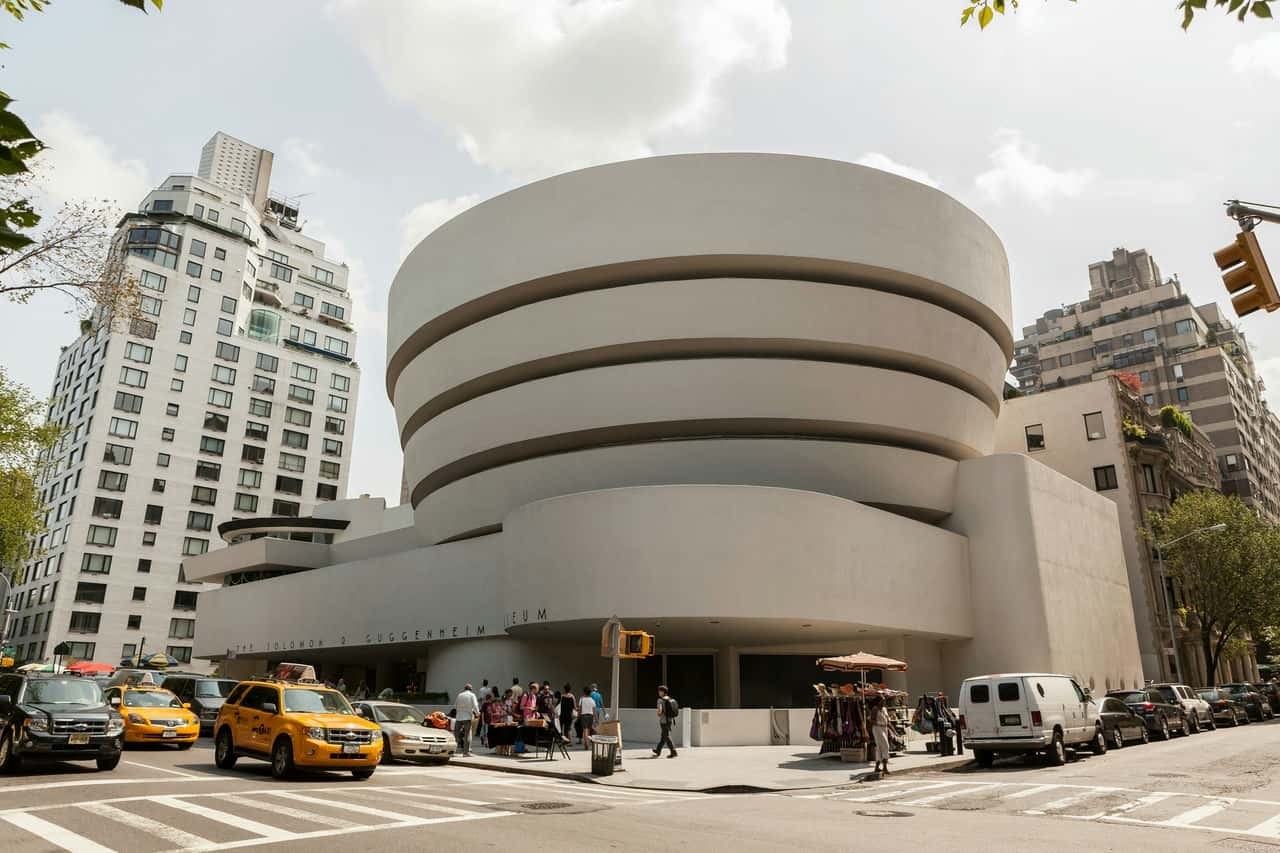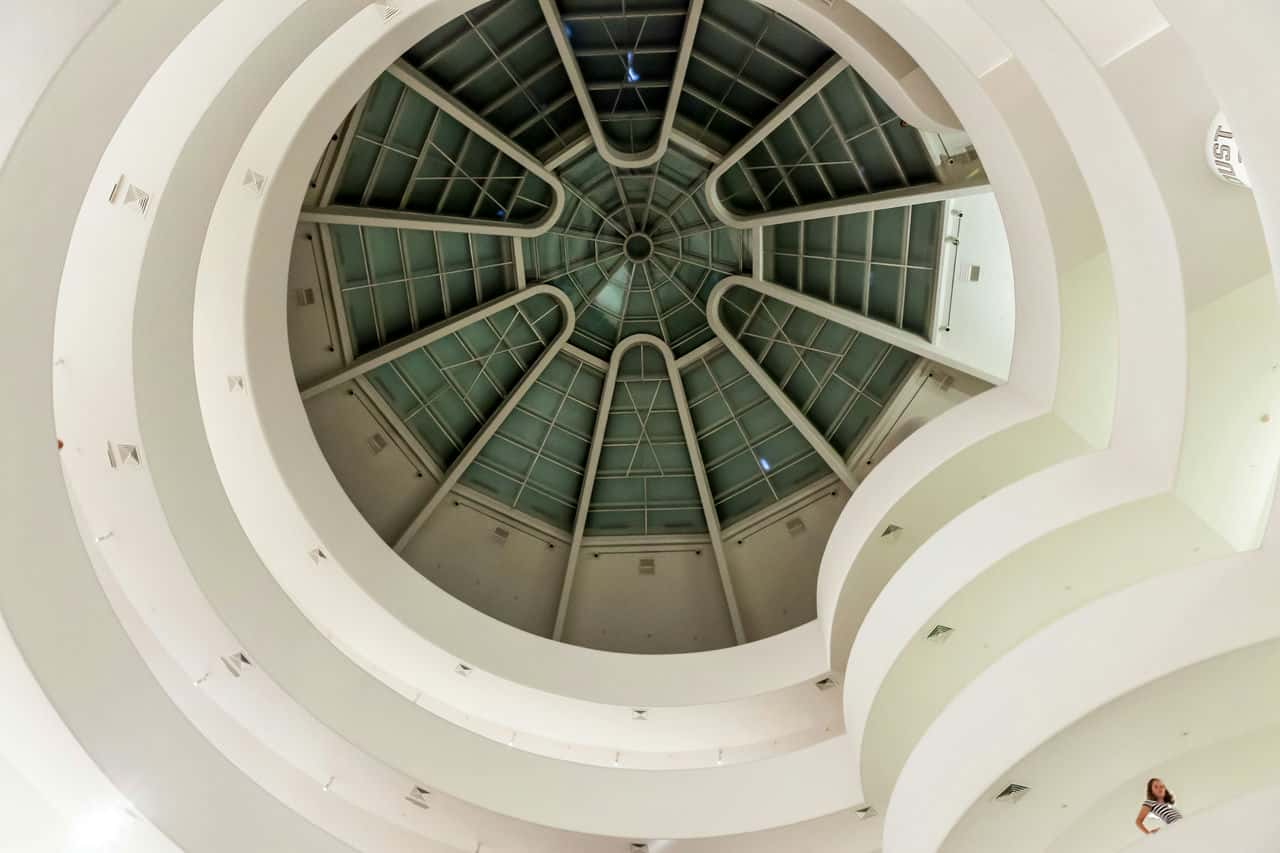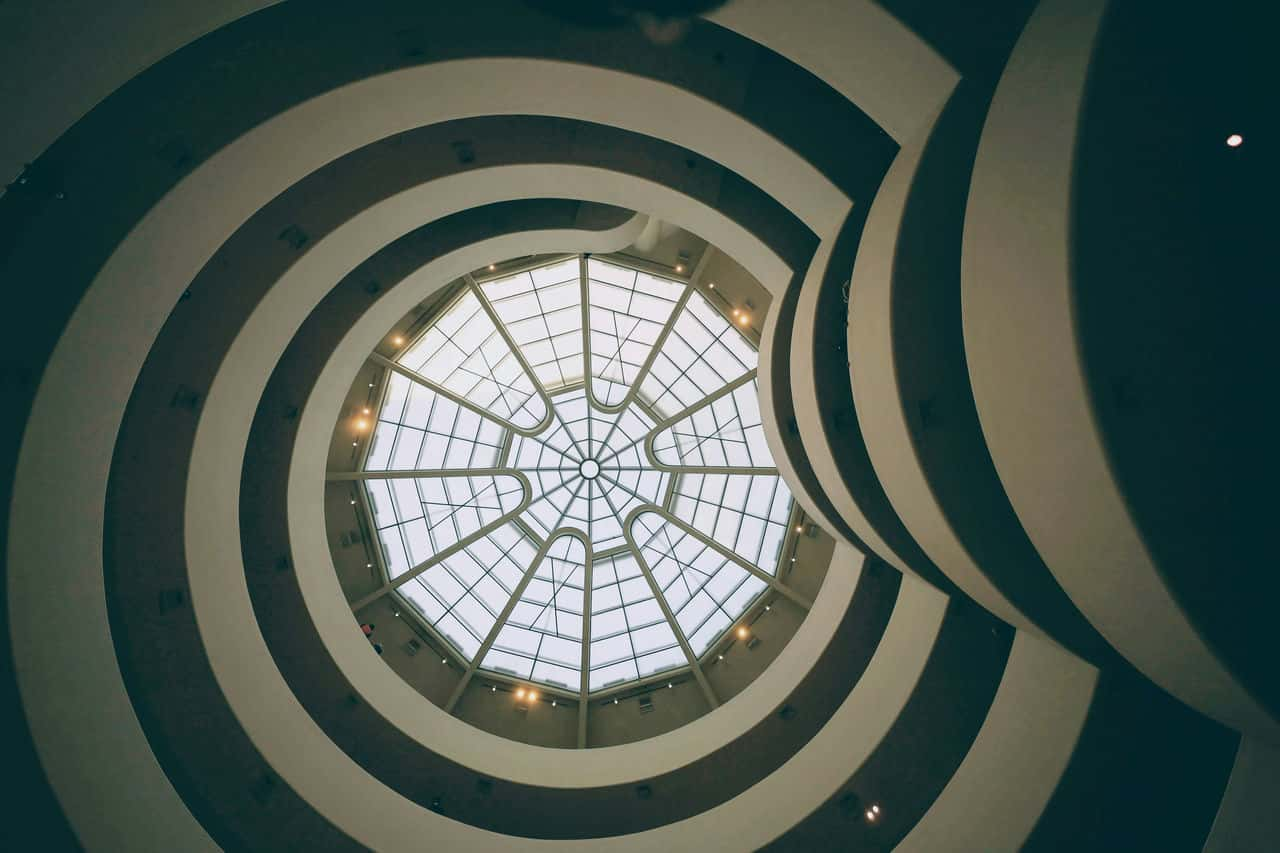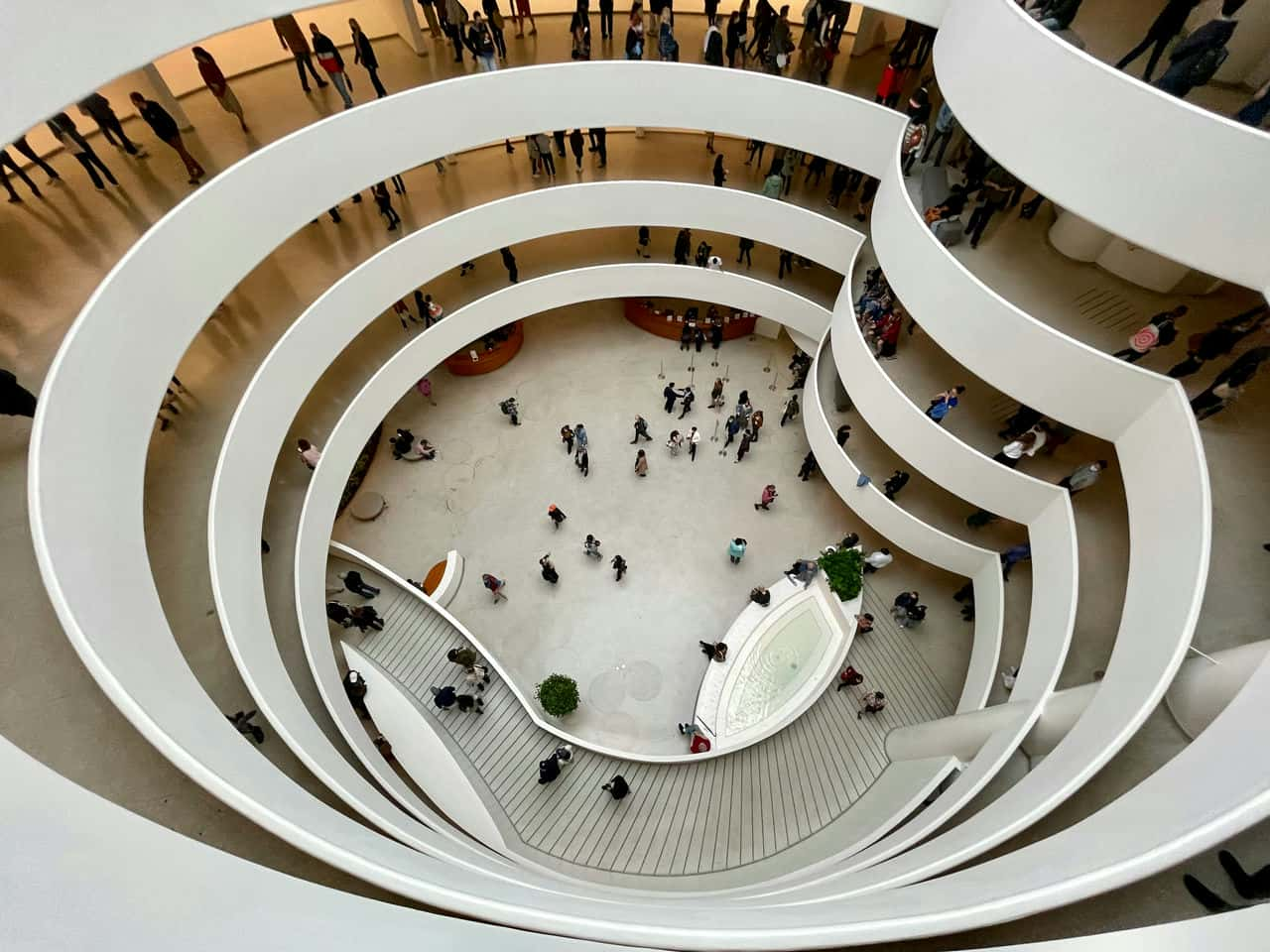The Guggenheim Museum, an iconic architectural landmark located on New York City’s Fifth Avenue, stands as a testament to the brilliance of famed American architect Frank Lloyd Wright. Commissioned by Hilla Rebay in 1943 and officially opening to the public in October 1959, six months after Wright’s demise, the museum’s construction marked the inception of a new era in museum design. The Guggenheim Museum is part of a broader network of modern and contemporary art museums under the Solomon R. Guggenheim Foundation. Wright’s design for the Guggenheim is a striking departure from traditional museum architecture. The building forms a brilliant white cylindrical stack that spirals upward, with galleries following the contours of a gently climbing, quarter-mile-long ramp under a 96-foot (29-meter) high glass dome. The museum’s prominence extends beyond New York City, with the Guggenheim network including the Peggy Guggenheim Collection in Venice, the Guggenheim Museum Bilbao in Spain, and the upcoming Guggenheim Abu Dhabi, designed by Frank Gehry. The Guggenheim Museum’s profound architectural influence represents a shift towards organic modernism. This organic dynamism redefined museum design, inspiring subsequent galleries globally and influencing architects such as Frank Gehry, Santiago Calatrava, and Zaha Hadid. Key structural engineering principles underpin the Guggenheim’s construction, featuring reinforced concrete, cantilever construction, and a design that effectively distributes weight and stress loads. The Guggenheim Museum serves as a home and display space for modern and contemporary art, its organic design providing a distinctive way to exhibit artworks along the spiraling ramp. The building’s maintenance involves ongoing efforts to preserve its iconic architecture, including exterior upkeep, interior repainting, and careful adjustment of displays. For architects and enthusiasts visiting the Guggenheim, specialized tours, such as the Architectural and Historical Tour, offer insights into Wright’s design, construction, and restoration. The museum’s role as a cultural landmark and tourist destination, coupled with its educational mission, underscores the success of Wright’s visionary design.
What is the Guggenheim Museum?
The Guggenheim Museum is a group of modern and contemporary art museums run by the Solomon R. Guggenheim Foundation. The museum is located at 1071 Fifth Avenue in New York City. Construction of this iconic museum began in 1956 based on a design by famed American architect Frank Lloyd Wright, with the museum opening to the public in October 1959, six months after Wright’s death. The building is a brilliant white cylindrical stack spiraling upwards, with the museum’s galleries following the contours of the building along a gently climbing, quarter-mile-long ramp under a 96-foot (29-meter) high glass dome. At 259,000 square feet (24,000 square meters) of space, the building has come to symbolize modern architecture and contains 10,765 square feet (1,000 square meters) dedicated to exhibition galleries. Since its opening, the Guggenheim Museum’s collection has grown to encompass European paintings from the mid-19th century to today and post-WWII American art.
The Peggy Guggenheim Collection is a separate Guggenheim museum housed in the Palazzo Venier dei Leoni in Venice. It was gifted to the Foundation in 1979 by Solomon Guggenheim’s niece, Peggy Guggenheim. The Guggenheim network expanded further in 1997 with the opening of the titanium, glass, and limestone Guggenheim Museum Bilbao in Spain, designed by Frank Gehry. It is as large as the New York Guggenheim and has become an architectural icon. The latest addition is the under-construction Guggenheim Abu Dhabi, designed by Frank Gehry, which will be the largest Guggenheim museum. The global expansion of the Guggenheim museums and contemporary art collections began under former director Thomas Krens in the 1990s. The Guggenheim Foundation continues to promote international collaborations and bring modern and contemporary art to new global audiences.

What architectural style is most prominent in the Leaning Guggenheim Museum?
The predominant architectural style of the Guggenheim Museum in New York City is Frank Lloyd Wright’s signature organic architecture. Wright’s design emphasizes curvilinear forms, integration with nature, and harmony between the building and art within. The museum’s white cylindrical structure grows seamlessly upward from the ground. Deviating sharply from the typical boxy museum layout, Wright opted for a gently twisting spiral design recalling shapes and flows found in nature. The museum’s flowing ribbons echo shells, plants, and other organic structures, allying with buildings and land. Wright pioneered this groundbreaking style for museum architecture, directly inspiring subsequent galleries globally. The Guggenheim’s signature organic dynamism has redefined museum design.
What structural engineering principles were employed in the construction of the Guggenheim Museum?
Several key structural engineering principles were employed in constructing the iconic Guggenheim Museum in New York City. Firstly, reinforced concrete was essential for realizing Frank Lloyd Wright’s vision. Concrete walls of varying thickness along the continuous spiraling ramp form the primary structural support, with the thickest walls at ground level and tapering as the structure ascends. Secondly, cantilever construction allows the exterior out over Fifth Avenue and interior ramps to defy gravity without underlying support. This was achieved by anchoring each cantilever section back to the central concrete spiral shaft. Thirdly, the design distributes weight and stress loads downwards effectively. The cylindrical building grows wider at its base, concentrating greater mass in the structure. This lowered center of gravity enhances overall stability. Narrow skylights running vertically along the exterior relieve concentrated force from upper levels. Lastly, specially engineered heating and cooling prevent thermal expansion strains on building materials. The glass dome at the museum’s apex required panes engineered to withstand wind shear and possible impacts.
Who designed the Guggenheim Museum?
Architect Frank Lloyd Wright designed the Guggenheim Museum. Wright was tasked with creating a new modern art museum in 1943 by Hilla Rebay. Over the next 16 years, until the museum opened in 1959, Wright made over 700 early designs and complete plans for the rooms inside and outside. His new design was very different from standard square gallery layouts. Instead, it had a gentle twisting spiral shape. This expressive building design combines avant-garde looks and real museum functions through engineering innovations. The final building resembles a round white tower spiraling towards a skylight dome. This fits Wright’s typical organic architecture, which focuses on flowing with nature. Inside, a long ramp gallery wraps around the central dome. This makes an uninterrupted space that gets visitors ready to see exhibits as part of the building around them. The Guggenheim greatly expanded ideas of what art museum form could be. The Guggenheim Museum is a monument to Wright’s vision of harmonious teamwork between manmade and organic things.
What are the historical design influences visible in the Guggenheim Museum?
Several key historical influences are evident in Frank Lloyd Wright’s distinct design for the Guggenheim Museum. Firstly, Wright drew inspiration from ancient ziggurat structures steep terraced temples built by Sumerians and Babylonians. This manifests in the museum’s ascending spiral walkway, guiding viewers higher while surveying artworks. Secondly, the building’s simple geometric form and ornamentation-free white exterior walls reflect the modernist “form follows function” ethos of reducing architecture to pure essentials. Thirdly, the museum’s curving organic dynamism and harmony with surrounding Central Park builds on Wright’s earlier prairie-style homes, emphasizing natural settings. Integrating building and environment was a prime theme of Wright’s oeuvre. Finally, Guggenheim’s unconventional open gallery departed from boxy museum norms in ways that presaged even more radical post-modern layouts. Wright helped pave the way for later deconstructivist museums.

How has the Guggenheim Museum influenced the design of other buildings in New York City?
The iconic Guggenheim Museum has influenced the design of other buildings in New York City in several key ways. Firstly, the Guggenheim pioneered a new sculptural, expressive approach to museum architecture that broke from the typical boxy gallery spaces of its time. NYC museums like the Cooper Hewitt and the new Whitney Museum echo the Guggenheim’s fluid curves and asymmetrical shapes. Secondly, the museum’s integration with its natural surroundings also set a precedent in the city. Later architects likewise designed buildings to connect with and complement NYC’s green spaces, like Yoshio Taniguchi’s serene Museum of Modern Art sculpture garden. Finally, the Guggenheim demonstrated architecture’s potential as a functional container, experience, and destination. The building’s unique spiraling ramp gallery made the space an artistic element influencing how audiences view art. This idea of enhancing the visitor experience through innovative architectural forms has impacted museums and other public buildings across the city.
What purpose does the Guggenheim Museum serve, and how does the design help?
The Guggenheim Museum in New York City is an iconic home and display space for modern and contemporary art. Its organic design was controversial yet highly influential, liberating museum architecture to be more expressive. The museum provides an exceptional area to exhibit artworks and shapes the viewer’s experience. Its ramp spiraling gently upwards creates a unique way to display art along the walls, enabling visitors on different levels to interact. Though criticized as distracting from the art, the design’s openness and natural lighting came to be appreciated. The building is considered a work of art that complements rather than competes with the contents. The museum has become a cultural landmark and popular tourist destination, introducing millions to modern art. Its success has spawned an international network of Guggenheim museums, expanding access to art globally. In serving these diverse purposes, Wright’s one-of-a-kind design was visionary. Its form and function align to create an immersive artistic experience that continues to educate and inspire.

How is the Guggenheim Museum maintained?
The Guggenheim Museum requires extensive maintenance to preserve its iconic architecture and correctly display its world-class art collection. Firstly, the building’s exterior requires regular upkeep. The concrete surface is prone to cracking over time due to weather and requires sealing. During a major 2005-2008 restoration, conservators had to remove 11 layers of paint to repair cracks before repainting it. Secondly, the interior ramp and galleries necessitate frequent repainting. The bright white walls show signs of wear with thousands of visitors daily. They also ensure optimal lighting, climate control, and security systems for protecting the artworks. Thirdly, the displays themselves need adjustment. Temporary exhibitions change frequently, and staff use specialized equipment to mount and take down artworks. They tweak the angle of pieces on the curved walls per the curator’s vision. Conservators maintain the frames and perform minor restorations on works if needed. The Guggenheim sustains Frank Lloyd Wright’s unique design while enabling exceptional modern art displays. The building’s upkeep is an art ensuring this 20th-century “architectural wonder” endures.
How does the Guggenheim Museum reflect cultural and contextual relevance in its design?
The Guggenheim Museum’s iconic spiral design by Frank Lloyd Wright is deeply, culturally, and contextually relevant in several key ways. Firstly, The Guggenheim was designed to be a modern “temple of spirit” to house Solomon Guggenheim’s growing collection of contemporary art. Wright’s design boldly broke with typical rectangular museum designs, creating an organic spiraling form reminiscent of a nautilus shell. This design innovation reflected the cultural zeitgeist of 1950s America when modernism, abstraction, and avant-garde styles were highly celebrated. Secondly, the museum’s location and physical form integrate beautifully into the surrounding urban context of Manhattan. Wright situated the museum along Central Park, harmonizing the curvilinear museum with the natural landscape. Finally, Wright pioneered a new paradigm for museum design with the Guggenheim. The expressive sculptural quality and visitor-centered interior spaces inspired countless other museums worldwide. The Guggenheim’s form and function encapsulated contemporary art and culture while evolving how museums could activate public spaces. Its iconic power reflects the deep integration of the building into the artistic and architectural culture of New York City and the 20th century more broadly.

What architectural trend or movement does the Guggenheim Museum represent?
The Guggenheim Museum represents the architectural style of organic modernism. The museum’s round shape makes natural forms like seashells and nautilus chambers. On a broader level, the Guggenheim’s biomorphic design signaled a significant shift in museum architecture towards more expressive and sculptural buildings that engage visitors emotionally. The museum building became a work of art, not just a container. This artistic sensibility aligned with the organic visual language of abstract art and sculpture being exhibited inside. The Guggenheim demonstrated architecture’s power to enhance the viewing experience through its form and spaces. Wright pioneered this organic approach to museum design, profoundly influencing later architects like Frank Gehry, Santiago Calatrava, and Zaha Hadid. The Guggenheim stands as one of the key prototypes of the expressive, curvaceous forms that defined museum architecture in the late 20th century through the present day.
What are the challenges faced during the restoration of the Guggenheim Museum?
The Guggenheim Museum has faced several key challenges throughout its history. Firstly, the museum’s flowing concrete facade and open, spiraling interior ramp are defining features. Restorers have had to strike a careful balance between enhancing functionality and retaining visual authenticity. Secondly, the building’s unconventional shape and layout have complicated access for maintenance and restoration. The continuous ramp wrapping a large atrium does not allow straightforward equipment transport and worker access. Custom scaffolding, restricted work hours, and creative logistics have been necessary to overcome these spatial constraints. Thirdly, the degradation of materials over time, especially exterior concrete, has required extensive testing and repair. Ongoing monitoring and future interventions will be needed. Preserving historical design, navigating challenging architecture, and remediating aged materials have made Guggenheim restoration an exacting endeavor requiring creative solutions to honor Wright’s while upgrading it for the 21st century.
How does the Guggenheim Museum comply with contemporary safety and accessibility standards?
The Guggenheim Museum has adapted to modern safety and accessibility standards while preserving the integrity of its historic design. Firstly, the building’s unique spiraling ramp system and open rotunda create inherent safety risks, including low parapet walls and staggered floor edges that pose fall hazards. Upgrading railings, adding protective barriers, and posting warning signage have helped mitigate some risks. As a landmark structure, priorities balance safety compliance, restoration accuracy, and maintaining the experience. Secondly, the museum’s layout presents accessibility obstacles. The inclined ramps winding through the building make wheelchair navigation impossible without assistance. Plans to further improve accessibility through a redesigned interior ramp system have stalled due to threats to the historic fabric. Finally, the building needs more capacity for modern climate control, security, lighting, and fire suppression systems. Visible changes like sprinklers and exit signage have been added only where strictly necessary per building codes. Guggenheim’s protected status as an architectural masterwork to improve safety and accessibility has been executed sensitively, but functional limitations inherently exist.
Are there any specific tours for architects or architecture enthusiasts visiting the Guggenheim Museum?
Yes, the Guggenheim Museum offers several touring options for architects, design professionals, and enthusiasts interested in exploring the building’s unique structure. The Architectural and Historical Tour focuses on Frank Lloyd Wright’s pioneering museum design. Guides discuss the building’s construction, engineering, and restoration, highlighting key spaces like the iconic dome. Wright’s original interior paint scheme and master architectural model are also examined. The museum also provides Private Architecture Tours for customized experiences analyzing particular structural aspects of interest. Options include emphasizing museum additions by Gwathmey Siegel & Associates or technical considerations like lighting innovations and environmental control systems enabling the spiraling galleries. These tours offer firsthand architectural discussion unavailable on standard visits. Architecture enthusiasts may reserve spaces like the Warner Education Center for privately guided lectures, films, and informal salon talks relevant to design. The museum aims to facilitate creative architectural dialogues with such programming.

What lessons can architects learn from the design and construction of the Guggenheim Museum?
The Guggenheim Museum offers several key lessons for architects regarding innovative design, functionality, and realizing a bold vision. Firstly, Wright demonstrated the power of rejecting orthodox design constraints to pioneer new architectural forms. The Guggenheim’s swirling organic shape that curves gently upward contrasts the rigid Manhattan grid. This willingness to be sculptural and expressive expanded concepts of what a museum could be and deeply influenced later architects to design signature buildings. Secondly, Wright needed help fully integrating the museum’s function with his aesthetic vision, revealing potential pitfalls when form overtakes practicality. Finding harmony between design and utility remains an ongoing challenge. Thirdly, despite early criticism of the building as too radical, Wright persevered in executing his concept. The completed museum is now an internationally recognized icon. This underscores the importance of conviction when introducing new ideas, which may meet resistance before being embraced. The Guggenheim fulfilled Wright’s dream of a modern “temple of spirit” that continues to inspire visitors.
What are the best architectural landmarks in New York City to visit as an architect?
Listed below are the best architectural landmarks in New York City to visit as an architect:
- Empire State Building: The Empire State Building is a must-visit for architects interested in the evolution of high-rise construction. Designed by Shreve & Lamb and completed in 1931, this iconic structure was once the world’s tallest building. Its distinctive stepped form and steel frame construction represent significant advancements in skyscraper technology. The building’s observation decks provide a unique perspective on New York City’s urban layout, making it not just an architectural icon but also a key vantage point for understanding the city’s development.
- Guggenheim Museum: The Guggenheim Museum by Frank Lloyd Wright is a landmark destination for architects exploring organic architecture. Opened in 1959, its unique spiral structure and continuous ramp challenge traditional museum layouts, offering an uninterrupted journey through the exhibits. Wright’s design philosophy, which sought harmony between the structure and its environment, is demonstrated in the museum’s integration with its urban context. The building’s form and function make it a pivotal study in architectural innovation.
- Chrysler Building: The Chrysler Building is an architectural symbol of the Art Deco era, making it an essential visit for architects studying this design movement. Completed in 1930 and designed by William Van Alen, its distinctive stainless steel crown and spire showcase exquisite decorative artistry. The building’s interior, especially its lobby, reflects the opulence of the late 1920s and early 1930s. It stands as a testament to the era’s architectural creativity and the technological advancements in skyscraper design.
- The High Line: The High Line is an outstanding example of urban regeneration and landscape architecture, offering architects insights into innovative urban design and public space revitalization. Transformed from an elevated freight rail line into a public park by Diller Scofidio + Renfro and James Corner, it blends horticulture, art, and design within a dense urban context. This project demonstrates the potential of adaptive reuse in urban environments and the integration of green spaces within cityscapes.
- One World Trade Center: One World Trade Center is a significant architectural site for architects interested in skyscraper design and urban resilience. Completed in 2014 and designed by David Childs of Skidmore, Owings & Merrill, it stands as a symbol of rebirth on the site of the original Twin Towers. The building features advanced safety and sustainability elements, making it a modern architectural marvel. Its design respects the site’s history while marking a new era in high-rise construction.
- Flatiron Building: The Flatiron Building is an architectural icon and a pioneering skyscraper in New York City, significant for architects studying early 20th-century urban architecture. Completed in 1902 and designed by Daniel Burnham, its unique triangular shape and Renaissance Revival style were innovative for its time. The building’s slender profile and distinct facade have made it a symbol of New York’s architectural heritage, offering insights into the city’s architectural evolution.
- Brooklyn Bridge: As one of the oldest suspension bridges in the United States, the Brooklyn Bridge is a landmark of engineering and architecture. Completed in 1883 and designed by John Augustus Roebling, it connects Manhattan and Brooklyn across the East River. The bridge’s Gothic-style stone towers and intricate cable arrangement make it a study in both aesthetic beauty and structural ingenuity. For architects, it represents a significant moment in the history of bridge design and urban connectivity.
- Seagram Building: The Seagram Building, designed by Ludwig Mies van der Rohe and Philip Johnson, is a fundamental site for architects interested in modernist architecture. Completed in 1958, this skyscraper is celebrated for its functional aesthetics and adherence to the ‘less is more’ philosophy. Its use of high-quality materials, like bronze and travertine, and the concept of the elevated plaza as an urban space, have influenced subsequent office building designs. The building exemplifies the International Style and has had a lasting impact on corporate architecture.


